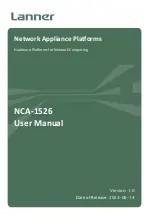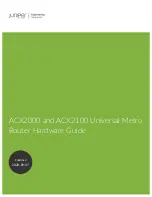
Chapter 11 Spanning Tree Protocol
ES-2048 User’s Guide
111
The following table describes the labels in this screen.
Table 28
Advanced Application > Spanning Tree Protocol > MSTP
LABEL
DESCRIPTION
Status
Click
Status
to display the
MSTP Status
screen (see
).
Active
Select this check box to activate MSTP on the Switch. Clear this checkbox to
disable MSTP on the Switch.
Note: You must also activate
Multiple Spanning Tree
in the
Advanced Application > Spanning Tree Protocol >
Configuration
screen to enable MSTP on the Switch.
Hello Time
This is the time interval in seconds between BPDU (Bridge Protocol Data Units)
configuration message generations by the root switch. The allowed range is 1 to
10 seconds.
MaxAge
This is the maximum time (in seconds) the Switch can wait without receiving a
BPDU before attempting to reconfigure. All Switch ports (except for designated
ports) should receive BPDUs at regular intervals. Any port that ages out STP
information (provided in the last BPDU) becomes the designated port for the
attached LAN. If it is a root port, a new root port is selected from among the Switch
ports attached to the network. The allowed range is 6 to 40 seconds.
Forwarding Delay This is the maximum time (in seconds) the Switch will wait before changing states.
This delay is required because every switch must receive information about
topology changes before it starts to forward frames. In addition, each port needs
time to listen for conflicting information that would make it return to a blocking
state; otherwise, temporary data loops might result. The allowed range is 4 to 30
seconds. As a general rule:
Note: 2 * (Forward Delay - 1) >= Max Age >= 2 * (Hello Time + 1)
Maximum hops
Enter the number of hops (between 1 and 255) in an MSTP region before the
BPDU is discarded and the port information is aged.
Configuration
Name
Enter a descriptive name (up to 32 characters) of an MST region.
Revision Number
Enter a number to identify a region’s configuration. Devices must have the same
revision number to belong to the same region.
Apply
Click
Apply
to save your changes to the Switch’s run-time memory. The Switch
loses these changes if it is turned off or loses power, so use the
Save
link on the
top navigation panel to save your changes to the non-volatile memory when you
are done configuring.
Cancel
Click
Cancel
to begin configuring this screen afresh.
Instance
Use this section to configure MSTI (Multiple Spanning Tree Instance) settings.
Instance
Enter the number you want to use to identify this MST instance on the Switch. The
Switch supports instance numbers 0-16.
Bridge Priority
Set the priority of the Switch for the specific spanning tree instance. The lower the
number, the more likely the Switch will be chosen as the root bridge within the
spanning tree instance.
Enter priority values between 0 and 61440 in increments of 4096 (thus valid values
are 4096, 8192, 12288, 16384, 20480, 24576, 28672, 32768, 36864, 40960,
45056, 49152, 53248, 57344 and 61440).
Summary of Contents for ES-2048
Page 2: ...ES 2048 User s Guide 2...
Page 7: ...Safety Warnings ES 2048 User s Guide 7 This product is recyclable Dispose of it properly...
Page 8: ...Safety Warnings ES 2048 User s Guide 8...
Page 20: ...Table of Contents ES 2048 User s Guide 20...
Page 28: ...List of Tables ES 2048 User s Guide 28...
Page 30: ...30...
Page 36: ...36...
Page 40: ...Chapter 2 Hardware Installation and Connection ES 2048 User s Guide 40...
Page 46: ...Chapter 3 Hardware Overview ES 2048 User s Guide 46...
Page 56: ...Chapter 4 The Web Configurator ES 2048 User s Guide 56...
Page 66: ...Chapter 6 System Status and Port Statistics ES 2048 User s Guide 66...
Page 78: ...Chapter 7 Basic Setting ES 2048 User s Guide 78...
Page 80: ...80...
Page 95: ...Chapter 8 VLAN ES 2048 User s Guide 95 Figure 41 Port Based VLAN Setup Port Isolation...
Page 128: ...Chapter 15 Link Aggregation ES 2048 User s Guide 128...
Page 138: ...Chapter 17 Port Security ES 2048 User s Guide 138...
Page 155: ...Chapter 19 Multicast ES 2048 User s Guide 155 Figure 80 MVR Group Configuration Example...
Page 156: ...Chapter 19 Multicast ES 2048 User s Guide 156...
Page 170: ...Chapter 20 Authentication Accounting ES 2048 User s Guide 170...
Page 195: ...195 PART IV IP Application Static Route 197 Differentiated Services 201 DHCP 209...
Page 196: ...196...
Page 200: ...Chapter 23 Static Route ES 2048 User s Guide 200...
Page 208: ...Chapter 24 Differentiated Services ES 2048 User s Guide 208...
Page 216: ...216...
Page 240: ...Chapter 27 Access Control ES 2048 User s Guide 240...
Page 242: ...Chapter 28 Diagnostic ES 2048 User s Guide 242...
Page 246: ...Chapter 29 Syslog ES 2048 User s Guide 246...
Page 260: ...260...
Page 264: ...Chapter 34 Troubleshooting ES 2048 User s Guide 264...
Page 272: ...Chapter 35 Product Specifications ES 2048 User s Guide 272...
Page 274: ...274...
Page 288: ...Appendix B Common Services ES 2048 User s Guide 288...
Page 292: ...Appendix C Legal Information ES 2048 User s Guide 292...
Page 298: ...Appendix D Customer Support ES 2048 User s Guide 298...
Page 306: ...Index ES 2048 User s Guide 306...
















































